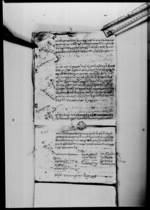A copy of a lālamohara from King Gīrvāṇayuddha re financing worship of Śrī Kālikā of Gorkhā's dasaĩghara (VS 1865)
ID: K_0020_0007B
Edited and
translated by Astrid Zotter
in collaboration with
Pabitra Bajracharya
Created: 2019-09-02;
Last modified: 2023-03-01
For the metadata of the document, click here
The accompanying edition, translation/synopsis and/or commentary are available under the terms of the Creative Commons Attribution-ShareAlike 4.0 International License
Abstract
This copy of a lālamohara from the king, who according to the date must have been Gīrvāṇayuddha, fixes 405¼ rupees as the annual sum for a revenue-collecting contract (ijārā) on 13 khetas of land in Purkoṭa dedicated in an act of ritual commitment (saṃkalpa) by the queen mother in VS 1856 (1799 CE) for financing the twice-monthly worship of Śrī Kālikā of Gorkhā's dasaĩghara.Diplomatic edition
[1r]
1⟪५२नं⟫1⟪पो७सी३६५पा∙४६⟫1स्हीरुजुना∙रा∙2वीस्नुडास्1भंनेस्हीनौमोहन1आगे५६∙साल्मा∙श्री∙मुमाज्युवाट∙गोर्खा∙दसैघरश्रीकालिकाकाचौवीसअष्ट∙
2मीका∙पुजानीवित्य∙संकल्प∙गरीराष्याकोपुर्कोट∙वारवर्नछ∙तीसै∙जातकोभन्यौं∙
3अपुतालिधर्माधीकार∙कल्यानधनसाऊन्या∙फागुदसैदंद∙कुंद∙घरगंनीऔ∙
4दर्वार∙वाट∙काअसमानी∙फरमानीपुर्कोट∙भित्रकोषेत∙१३।सर्वअंक
5मारीमेटी∙श्रीकालिकालाई∙चर्हायाको∙तेसजगा∙माये़कसाल्कोज्मा∙
6रुपैञाचारसैसावा∙पाच∙४०५।श्री∙मुमाज्युकेईजारागरीवक्स्य़ौंऔ∙
7गुटिकाजगा∙भित्रदर्वार∙वाटअसमानीफर्मानीकाहकालाजफतलेऊका
8ईदीय़ाईजाराध⟪दा⟫रलाई∙मीनहामोजरावक्स्यौंलागुटिवाटल्याय़ाकोमी⟪मा⟫ल
9मताकोजगातभन्सार∙नतीर्नुगुटिभित्र∙कोमानीसलेगुटिकोसराजाम∙
10वोकनुईती१८६५साल∙मार्गसुदी१रोज७सुभ्¯¯¯ ¯¯¯ ¯¯¯
Translation
[1r]
[In the left margin:]
no. 521
Bundle (po[kā]) 7 sī 365 pā 462
Signature: Deputy (nā[yaba]) Rā[iṭara]Vīsnuḍās, present (ruju) [when the copies were checked] 3
The one who said (i.e. read out): signature of Nau[sindā]Mohana
[Main text:]
Āge: We stated that Purkoṭa, which was established [as a guṭhī] by [my] venerable mother making a ritual commitment (saṃkalpa) in the year [VS 18]564 to [fund] worship (pūjā) on the twenty-four aṣṭamī days of Śrī Kālikā of Gorkhā's dasaĩghara, [is a domain] of the four caste-classes (varṇa) and 36 caste groups (jāta).5
13 khetas [of land] within Purkoṭa have been offered to Śrī Kālikā as exempt from all taxes and levies (sarva aṅka mārīmeṭī)—[including those relating to] escheatable property (aputālī), the dharmādhikāra, unclaimed wealth (kalyāṇadhana), levies collected during the months of Śrāvaṇa and Phālguna (sāune phāgu) and on Dasaĩ, judicial fines (daṇḍakuṇḍa), homestead levies (gharagantī) along with unscheduled levies (asmānī) and special requests (pharmānī) from the royal court. We fix 405¼ rupees per year on this land as [the revenue sum to be collected] under ijārā [contract] for [the grant made by our] venerable mother. And we will cancel or recompensate to the tax contractor (ijārādāra) whatever is extracted from the guṭhī's land by force as levies and special orders from the royal court. Goods (mālamatā6 ) transported from the guṭhī are not to be submitted to transit (jagāta) or customs (bhansāra) duties. Persons from within the guṭhī shall carry the the guṭhī's items for worship [to the place of worship].
Saturday, the 1st of the bright fortnight of Mārga in the [Vikrama] era year 1865 (1808 CE).7 Auspiciousness.
Commentary
The document fixes conditions for a revenue-collecting contract (ijārā) to benefit a guṭhī endowment for worshipping Śrī Kālikā at Gorkha Palace for which the ritual commitment (saṃkalpa) had been made by the king's mother, Kāntavatī Devī, in VS 1856 (1799 CE). The annual contractual sum, which a contractor would have to submit in advance for the right to collect the revenue from the 13 khetas (or, as the founding charter says 1,300 muris), is fixed at 405¼ rupees.
It is not clear from what point on the guṭhī started operating to provide worship material, as the original dānapatra, which would have identified the exact borders of the endowed plots and laid out the material provisions to be provided, has not yet been traced.8 It must have existed, as a reissued version of it from VS 1942 (K_0120_0024) mentions these details. It also remains unknown from what point on and for how long revenue was farmed under an ijārā contract. Appointments of caretakers of the guṭhī issued between VS 1876 (K_0015_0022B) and VS 1890 (K_0003_0035C) make no mention of ijārā obligations or tax collectors, but rather read as if the caretaker (akhtiyārī) appointed was directly responsible for procuring the needed material from the revenue of the land endowed. In the reissued version of the dānapatra a contractor is mentioned, though.

